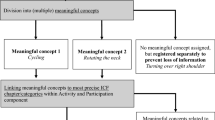Abstract
The disability caused by the musculoskeletal signs and symptoms affects the quality of life of a population, especially that related to health. The objective of this study is to evaluate the functional capacity of individuals of the Brazilian population who presented musculoskeletal signs and symptoms (MSK-S). The prevalence of MSK-S was evaluated in 5000 individuals (>15 years) in 16 capitals from the five regions of Brazil using the COPCORD Core Questionnaire. Those individuals (n = 2494) that experienced MSK-S and referred some level of disability at the time of the interview were invited to complete the Health Assessment Questionnaire-Disability Index (HAQ-DI). The HAQ-DI scores were compared among regions, and subgroups according to gender, age and type of activity. Three hundred ninety-four (7.9 %) participants reported disability at the time of the interview. The average score of HAQ-DI was 1.09 (SD = 0.71), and the Brazilian region with the highest level of disability was the North region. Among individuals without history of trauma, the disability was higher when the duration of MSK-S was longer. Disability was shown to worsen with increasing age, and the group with 25–34 years showed the lowest scores. Females showed worse functional capacity scores compared to males (p = 0.002). Individuals showed higher degrees of difficulty or were incapable of performing the activities walking, reaching, usual activities and dressing. MSK-S reduce the functional capacity of individuals of the Brazilian general population. The reduction in functional capacity was mainly observed in individuals with chronic musculoskeletal complaints not due to trauma, as well as in female gender and in advancing age.
Similar content being viewed by others
References
Chopra A, Saluja M, Patil J, Tandale HS (2002) Pain and disability, perceptions and beliefs of a rural Indian population: a WHO-ILAR COPCORD study. WHO-International League of Associations for Rheumatology. Community Oriented Program for Control of Rheumatic Diseases. J Rheumatol 29:614–621
Darmawan J, Ferraz MB, Muirden KD, Tugwell P (1995) Case study: World Health Organization-International League of Associations for Rheumatology Community-Oriented Programme for the Control of Rheumatic Diseases (WHO-ILAR COPCORD) in Indonesia and Brazil. Int J Technol Assess Health Care 11:700–708
Pereira AM, Valim V, Zandonade E, Ciconelli RM (2009) Prevalence of musculoskeletal manifestations in the adult Brazilian population: a study using COPCORD questionnaires. Clin Exp Rheumatol 27:42–46
Mathew AJ, Chopra A, Thekkemuriyil DV, George E, Goyal V, Nair JB et al (2011) Impact of musculoskeletal pain on physical function and health-related quality of life in a rural community in south India: a WHO-ILAR-COPCORD-BJD India study. Clin Rheumatol 30:1491–1497
Censo IBGE (2010) Available from: http://censo2010.ibge.gov.br/en/. Acessed 28 Sept 2014
Bennett K, Cardiel MH, Ferraz MB, Riedemann P, Goldsmith CH, Tugwell P (1997) Community screening for rheumatic disorder: cross cultural adaptation and screening characteristics of the COPCORD Core Questionnaire in Brazil, Chile, and Mexico. The PANLAR-COPCORD Working Group. Pan American League of Associations for Rheumatology. Community Oriented Programme for the Control of Rheumatic Disease. J Rheumatol 24:160–168
Ferraz MB, Oliveira LM, Araujo PM, Atra E, Tugwell P (1990) Crosscultural reliability of the physical ability dimension of the health assessment questionnaire. J Rheumatol 17:813–817
Al-Awadhi AM, Olusi SO, Moussa M, Shehab D, Al-Zaid N, Al-Herz A, Al-Jarallah K (2004) Musculoskeletal pain, disability and health-seeking behavior in adult Kuwaitis using a validated Arabic version of the WHO-ILAR COPCORD Core Questionnaire. Clin Exp Rheumatol 22:177–183
Chaiamnuay P, Darmavan J, Muirden KD, Assawatanabodee P (1998) Epidemiology of rheumatic disease in rural Thailand: a WHO-ILAR COPCORD study. J Rheumatol 25:1382–1387
Llerena GAR, Toledano MG, Martínez AAH, Otero ZAG, Varela JA, Cardiel MH (2000) Prevalence of musculo- skeletal complaints and disability in Cuba. A community-based study using the COPCORD core questionnaire. Clin Exp Rheumatol 18:739–742
Krishnan E, Sokka T, Häkkinen A, Hubert H, Hannonen P (2004) Normative values for the Health Assessment Questionnaire disability index: benchmarking disability in the general population. Arthritis Rheum 50:953–960
Chaaya M, Slim ZN, Habib RR, Arayssi T, Dana R, Hamdan O, Assi M, Issa Z, Uthman I (2012) High burden of rheumatic diseases in Lebanon: a COPCORD study. Int J Rheum Dis 15:136–143
Acknowledgments
This study was supported by Brazilian Health Ministry-Cooperation Term with Universidade Federal de São Paulo #136/2011.
Conflict of interest
The authors declare no conflict of interest.
Author information
Authors and Affiliations
Corresponding author
Rights and permissions
About this article
Cite this article
Jennings, F., Sato, E.I., da Rocha Castelar Pinheiro, G. et al. Evaluation of functional capacity in individuals with signs and symptoms of musculoskeletal disease: results of the BRAZCO population study (Brazilian COPCORD Study). Rheumatol Int 35, 1873–1879 (2015). https://doi.org/10.1007/s00296-015-3299-9
Received:
Accepted:
Published:
Issue Date:
DOI: https://doi.org/10.1007/s00296-015-3299-9



